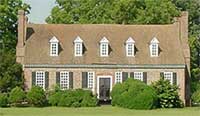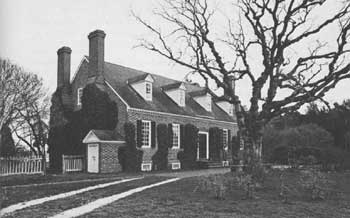







Survey of
Historic Sites and Buildings
 |
GEORGE WASHINGTON BIRTHPLACE NATIONAL MONUMENT Virginia |
 George Washington Birthplace National Monument |
| ||
The memorial mansion at this site along the Potomac symbolizes Wakefield, where Washington was born on February 22, 1732, and spent the first 3 years of his life. His family then moved farther up the river to the Little Hunting Creek plantation that later came to be known as Mount Vernon.
In 1717 or 1718 Augustine, George's father, bought land fronting on Popes Creek, a mile southeast of his home on Bridges Creek. On this tract, some three-quarters of a mile above the point where the creek empties into the Potomac, probably in the 1722-26 period he built the residence that became known as Wakefield. He and his family soon moved in. His first wife, Jane Butler, died in late 1729. Two years later, he brought his new wife, Mary Ball, to reside there.
George Washington, who was born the next year, as their first child, never owned Wakefield. Upon the death of his father in 1743, it passed to George's older half-brother, Augustine, Jr. At that time, George, aged 11, may have returned for awhile to attend a nearby school. Because he was close to his half-brother, in subsequent years he visited often.
When Augustine, Jr., died in 1762, his son William Augustine was only 5 years old. The latter inherited the plantation in 1774, when his mother passed away. Although he was only 17, that same year he married and assumed responsibility for the estate. After fire accidentally destroyed the home in 1779 or 1780, he moved to another location. The house was never rebuilt.
For many years, the site of Wakefield lay neglected and forgotten. The first person to place a marker there was George Washington Parke Custis, grandson of Martha and erstwhile ward of George Washington. In June 1816 he held a memorial ceremony at the probable house site and placed a freestone slab marker; eventually it disappeared.
In 1856 William Lewis Washington, a family heir, offered to donate a small plot of land at the site of the house and the nearby family burial ground to the State. Two years later, Virginia accepted the donation, planning to mark and preserve the sites, but the political turmoil generated by the approach of the Civil War was likely the reason this was not done.
In 1882 the State donated the property to the Federal Government, which the next year acquired additional acreage. In 1895-96 the Government placed a granite shaft at the site. In 1923 the Wakefield National Memorial Association organized to reconstitute and preserve the plantation as a national shrine. Several years later, Congress authorized the creation of a house at Wakefield as nearly as possible like the one built by Augustine Washington. By 1931-32 the association, aided by John D. Rockefeller, Jr., had transferred to the Government enough land to bring the holdings to about 394 acres.
Extensive research failed to yield reliable information about the appearance of the birthplace house. Consequently, the memorial house is only a general representation of a Virginia plantation residence of the 18th century. Its design is based on tradition and surviving houses of the period. Archeological excavations by the National Park Service and others, however, have revealed foundation remnants that might well be those of the original structure.
 |
| Washington Birthplace National Monument. (National Park Service (Frear, 1972).) |
The memorial house was built in 1931-32, at which time workers moved the granite shaft to its present location, near the entrance to the national monument. The Federal Government paid part of the construction and landscaping costs.
The typically Georgian residence, of brick made from clay obtained in an adjoining field, is 1-1/2 stories high. It has pairs of buttressed chimneys at each end and a gabled roof. Four rooms are downstairs and four upstairs. Central hallways divide the chambers on each floor. A tilt-top table in the dining room is the only piece of furniture that may have been in the original residence. The rest of the furnishings, however, date from the first half of the 18th century.
About 50 feet from the house is a typical Colonial frame kitchen, built on the traditional site. One of its two rooms is furnished to represent a plantation kitchen during the period of Washington's youth; the other displays artifacts recovered on the grounds.
Plantings near the house may be derived from those that grew on the place when Washington lived there as a boy. The nearby garden features only those flowers, vines, herbs, and berries common to Virginia gardens of his time. South of the garden, a grove of eastern red cedar trees covers Burnt House Point, which juts out into Popes Creek.
About a mile northwest of the memorial mansion, on the banks of Bridges Creek, are the family burial plot and the site of the home that John Washington, George's great-grandfather, purchased in 1664. The burial plot, surrounded by a brick wall, includes the graves of George Washington's father, grandfather, great-grandfather, and half-brother Augustine, Jr. George was buried at Mount Vernon.
Additional features of the national monument are a "living farm" and a Morgan horse farm. The former recreates a typical agricultural setting of Washington's day. The livestock, poultry, and crops are the same types and varieties raised then and are nurtured by colonial methods. The latter farm breeds Morgan horses, a special stock dating back to the late 18th century that the National Park Service uses for ranger patrol.
 |
 |
http://www.cr.nps.gov/history/online_books/constitution/site29.htm
Last Updated: 29-Jul-2004